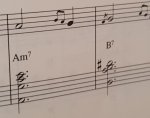P
Panya37
Guest
OK, while we are on the topic of fingering, I am really struggling with a tricky bass jump from Am7 (Cmaj + A) to B7+B in a gorgeous version of the Gaelic song 'Fear a 'Bhata'. I have a 72 bass. I do practice it a lot, but at the moment it seems to require luck to get there. I don't really have time to find the marked E to give me a reference point. Can anyone suggest a better strategy? Or an alternative?

